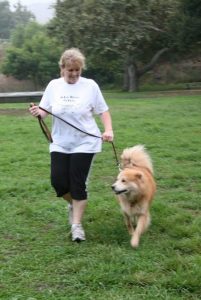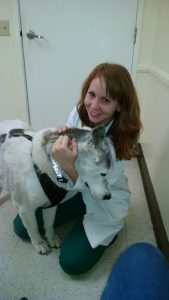
Bite wounds are often disguised by fur and can develop into an abscess if they are not discovered and immediately treated. Just because you don’t see blood, DO NOT assume that your dog has not been bitten after a squabble with another animal. Feel him all over gently and carefully. He will let you know if you touch a sore spot. X-rays or ultrasounds might be needed to diagnose internal bleeding and damage, especially in the case of animal bites since the tearing of deep layers of muscle may have occurred. Large animals are capable of inflicting bone crushing injuries. Deep injuries around the neck and chest are commonly seen if a smaller animal is picked up and shaken by a larger one.
PREVENTIVE MEASURES
- Keep cats indoors to prevent injuries.
- When walking your dog, keep your dog on-leash and keep your eyes peeled to the path ahead checking for glass and other sharp objects of course, but also for stray dogs. Read my article, “Protecting Your On Leash-Dog.”

SIGNS & SYMPTOMS:
- Bleeding
- Skin cut, scraped or torn away
- Puncture
- Pain
- Limping
- Licking at body parts
WHAT YOU MAY NEED:
4 X 4 Gauze squares
Gauze roll
Self-adhering compression bandage or adhesive tape
Saline solution
Antibacterial Soap, Chlorhexidine, Hibiclens®
 WHAT TO DO:
WHAT TO DO:
Stop bleeding by applying direct pressure. If the wound is not bleeding, rinse with saline solution or antibacterial soap – NEVER pour Hydrogen Peroxide into a deep wound! Puncture wounds that penetrate all layers of the skin can allow bacteria to penetrate deeply into the body. As the tissue begins to close, the bacteria can quickly get trapped and cause infection, so get to your Veterinarian at once.
If the puncture is from an animal bite, find out if other animal is current on his vaccinations (if possible). Pain, redness and infection can occur around untreated areas and your pet may develop a fever, loss of appetite and become lethargic. Antibiotics most likely will be needed to get him through this episode.

The cavity inside your pet’s chest normally allows the lungs to easily expand when air is inhaled. However, when an object protrudes the chest wall, air gets sucked into the
chest cavity and that pressure collapses the lungs, preventing them from expanding and resulting in suffocation. This sort of injury, caused by a bite or piercing object (including a knife, bullet, arrow, stick or even a broken rib), is commonly called a sucking wound because of the way air is pulled into the hole made by the object. Even if nothing appears to have punctured an animal’s chest, if you hear a gurgling sound and/or see frothy blood, something (most likely a rib) has penetrated. This is a life-threatening emergency!
SIGNS & SYMPTOMS:
- Bubbling of blood at chest site
- Slow breathing or fast and labored
- Abdomen may move more with each breath
- Animal may try stretching neck to facilitate breathing
WHAT YOU MAY NEED:
Gauze squares
Gauze rolls
K-Y Jelly® or other water soluble gel
Honey or Karo® syrup
Plastic wrap
Adhesive tape or self-adhering wrap
Towels/blankets
WHAT TO DO:
Your goal is to make a one-way valve that prevents air from being sucked into the chest cavity. You want to re-establish the normal “vacuum” that should exist in the cavity, prevent lung collapse and help pet breathe easy until medical help is available.
- Treat your pet for shock after checking CRT. Keep him warm and put a drop or two of honey or Karo® Syrup on his gums.
- If the wound has a small opening, seal it with a big glob of K-Y Jelly® to prevent incoming air from collapsing the lung.
- Place clean gauze or plastic wrap (even a plastic baggie will suffice) on top of the opening and hold in place with tape on 3 of the 4 sides. When the animal inhales, his lungs will push air out of the chest cavity and back through the hole, so your bandaging will need to lift on that one side to release air from the body. When the animal exhales, and the lungs deflate, the sucking wound will pull the plastic back against the hole and prevent additional air from entering the chest and collapsing the lung.
- If the wound is too large for water soluble lubricating jelly, cover tightly with plastic wrap to form a seal and tape it in place. If possible, have the pet lie on the injured side to keep pressure on the bleeding and help seal the hole.
- Get Immediate Veterinary Attention.
For 20 years Denise Fleck’s Sunny-dog Ink motto has been “Helping people to help their pets,” and she has…personally having taught close to 20,000 pet lovers animal life-saving skills and millions more on “The Doctors,” CNN, “Kirstie Alley’s Big Life,” Animal Planet and other TV shows. Denise is a frequent conference speaker, developed a line of pet first aid kits, written a dozen books and now offers classes online.
Note: The articles on this page are copyrighted. Please do not reprint or use portions for any purpose without written permission from the author. Request permission for usage by sending an email explaining how you’d like to use the materials and what parts specifically. Thank you in advance!









